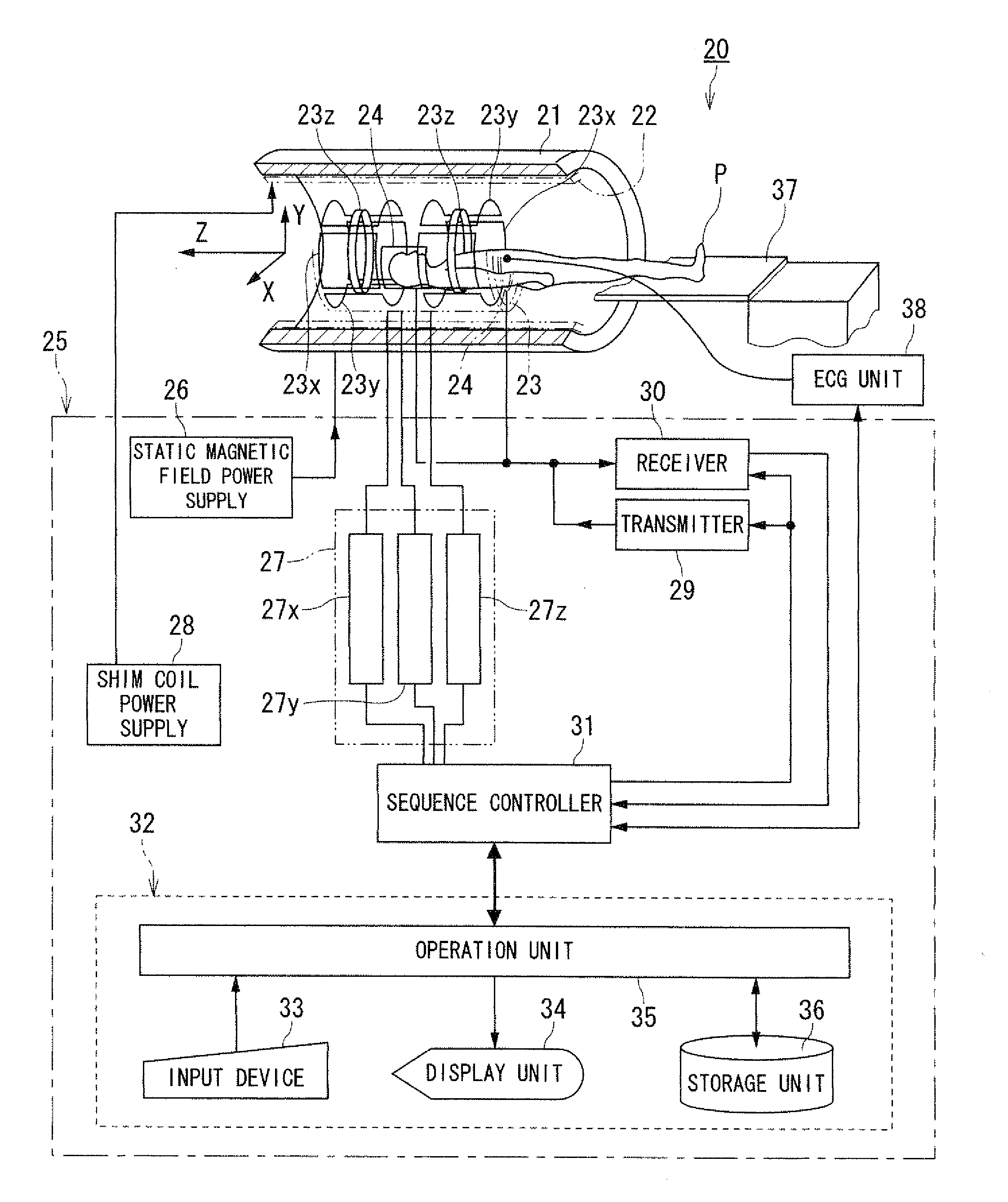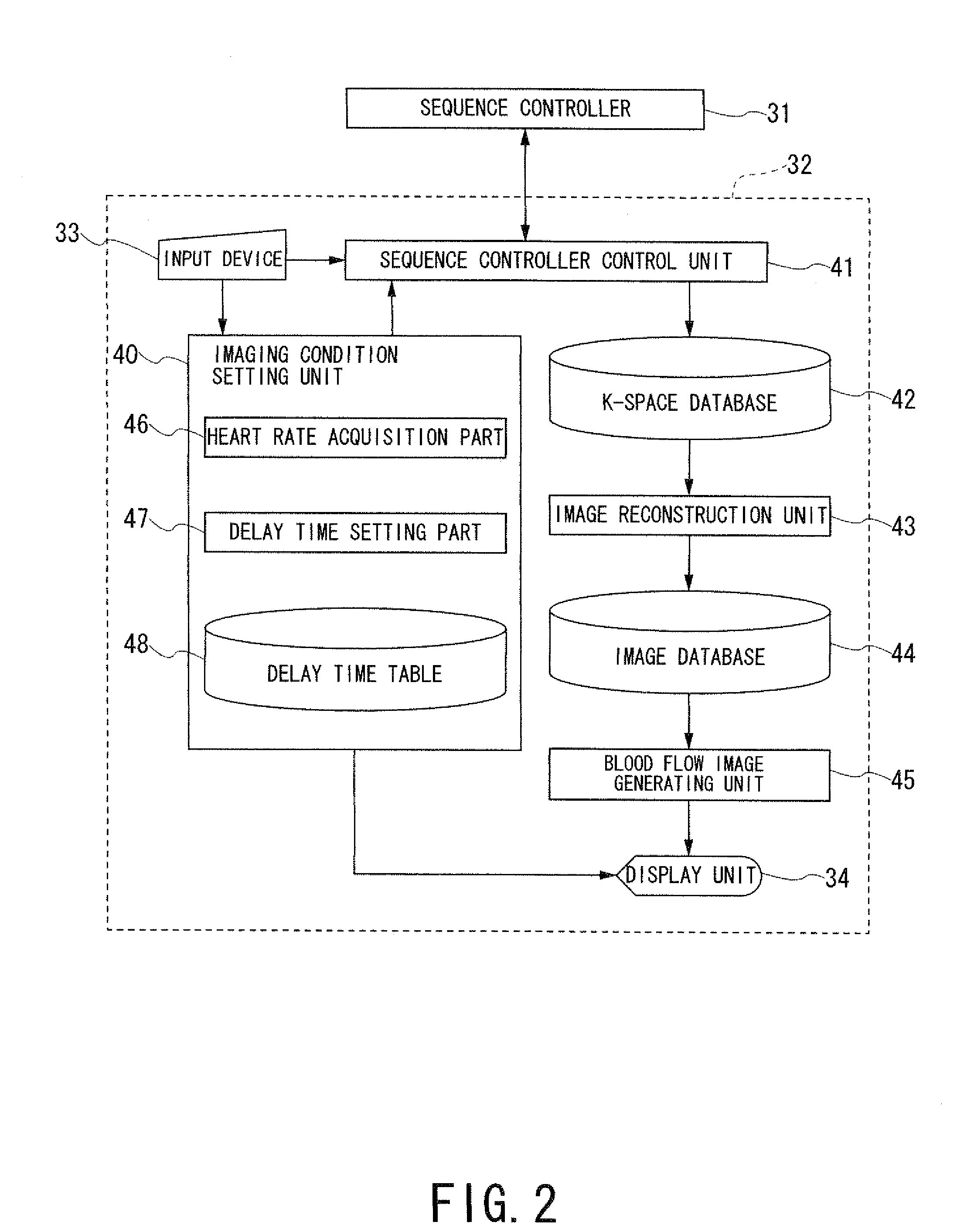Magnetic resonance imaging apparatus and magnetic resonance imaging method
a magnetic resonance imaging and magnetic resonance imaging technology, applied in the field of magnetic resonance imaging apparatus and magnetic resonance imaging method, can solve the problem of difficult to determine the delay time of ecg synchronous, and achieve the effect of facilitating acquisition of blood flow image data
- Summary
- Abstract
- Description
- Claims
- Application Information
AI Technical Summary
Benefits of technology
Problems solved by technology
Method used
Image
Examples
first modification
1. First Modification
[0096]In the embodiment described above, an example where a delay time is determined depending on imaging conditions such as an R-R, a systole SD, a diastole DD and an imaging part and is corrected with using a correction coefficient k is described. However, as shown in FIG. 4, plotted data of previous appropriate delay times DTsys_measured and DTdias_measured regarding as plural objects per HR are acquired in advance by an arbitrary method such as an ECG-prep scan and the appropriate delay times for respective HRs may be stored in the delay time table 48. The empirical delay times for the respective HRs stored in the delay time table 48 may be a table that relates numerical values of delay time obtained by curve fitting of plotted data of the delay time to HR values or an approximate curve (function) that represents delay times for respective HRs obtained by curve fitting of the plotted data of the delay time.
[0097]Then, the delay time setting part 47 has only ...
second modification
2. Second Modification
[0100]When synchronization imaging is performed by using a PPG signal as described above, a sensor of a PPG signal detection unit is attached with an appropriate part of the object. In this case, a delay time from a reference wave of a PPG signal to a data acquisition trigger can be set automatically with a reference interval acquired from the PPG signal. Note that, while a HR is acquired from an ECG signal acquired separately, peripheral pulse wave synchronous imaging can be also performed by using a data acquisition trigger generated based on a PPG signal. In this case, it is necessary to convert a delay time for ECG synchronization determined based on a HR to a delay time for peripheral pulse wave synchronization.
[0101]For example, peripheral pulse wave synchronous imaging for a lower thigh can be performed by attaching a peripheral pulse wave sensor with a hand of an object together with acquiring a HR from an ECG signal. Here, a trigger obtained from the P...
third modification
3. Third Modification
[0105]In the embodiment described above, an example that a delay time is corrected by using a correction coefficient k for reducing the influence of fluctuation in reference wave interval such as R-R interval is described. However, the delay time may be used without the correction. In this case, when a systole SD is calculated, the systole SD may extend over the following heart rate. That is, there is a possibility that a data acquisition timing becomes just before an R wave. Therefore, it is preferable to calculate the systole SD within at least one heart rate thought to be the minimum.
[0106]For that reason, threshold processing function that sets a systole SD to the upper limit within a minimum heart rate period when the systole SD exceeds a threshold value corresponding to the minimum heart rate period can be provided with the delay time setting part 47. In other words, the equation (3) can be determined so that the delay time DT is calculated discontinuously...
PUM
 Login to View More
Login to View More Abstract
Description
Claims
Application Information
 Login to View More
Login to View More - R&D
- Intellectual Property
- Life Sciences
- Materials
- Tech Scout
- Unparalleled Data Quality
- Higher Quality Content
- 60% Fewer Hallucinations
Browse by: Latest US Patents, China's latest patents, Technical Efficacy Thesaurus, Application Domain, Technology Topic, Popular Technical Reports.
© 2025 PatSnap. All rights reserved.Legal|Privacy policy|Modern Slavery Act Transparency Statement|Sitemap|About US| Contact US: help@patsnap.com



